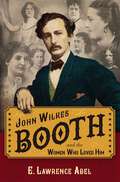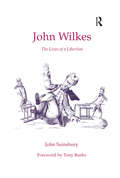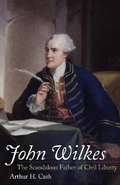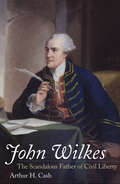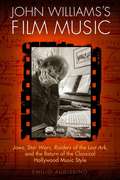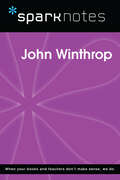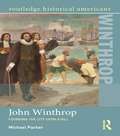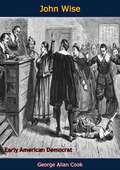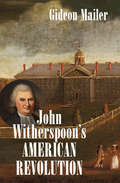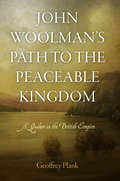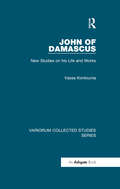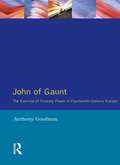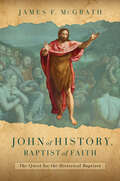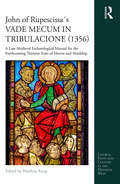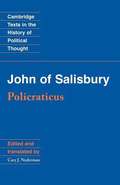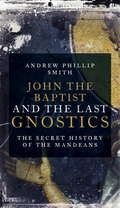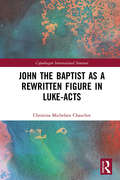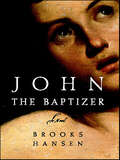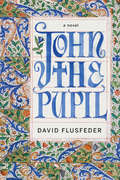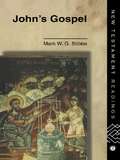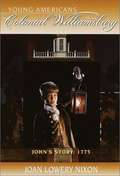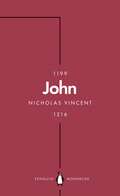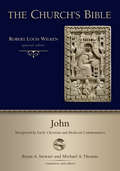- Table View
- List View
John Wilkes Booth and the Women Who Loved Him
by E. Lawrence AbelWhen John Wilkes Booth died—shot inside a burning barn and dragged out twelve days after he assassinated President Lincoln—all he had in his pocket were a compass, a candle, a diary, and five photographs of five different women. They were not ordinary women. Four of them were among the most beautiful actresses of the day; the fifth was Booth's wealthy fiancée. And those five women are just the tip of the iceberg. Before he shot the president of the United States and entered the annals of history as a killer, actor John Wilkes Booth had quite a way with women. There was the actress who cut his throat and almost killed him in a jealous rage. There was the prostitute who tried to kill herself because he abandoned her. There was the actress who would swear she witnessed him murdering Lincoln, even though she was thousands of miles away at the time. John Wilkes Booth was hungry for fame, touchy about politics, and a notorious womanizer. But this book isn't about John Wilkes Booth---not really. This book is about his women: women who were once notorious in their own right; women who were consumed by love, jealousy, strife, and heartbreak; women whose lives took wild turns before and after Lincoln's assassination; women whom have been condemned to the footnotes of history... until now.
John Wilkes: The Lives of a Libertine
by John SainsburyJohn Wilkes remains one of the most colourful and intriguing characters of eighteenth-century Britain. Born in 1725, the son of a prosperous London distiller, he was given the classical education of a gentleman, before entering politics as a Whig. Finding his party in opposition following the accession of George III in 1760 he took up his pen with sensational effect, and made a career out of excoriating the new administration and promoting the Whig interest. His charismatic style and vicious wit soon ensured that he became a figurehead for the radical cause, earning him many admirers and many enemies. Amongst the latter were the king, and the artist William Hogarth who famously depicted Wilkes as a grinning, squint-eyed, pug-nosed agent of misrule. Whilst Wilkes's political career has been much explored, particularly the period between 1763 and 1774, much less has been written about his remarkable private life. This biography provides a more comprehensive examination of Wilkes throughout his long life than has hitherto been available. Taking a thematic, rather than chronological approach it is divided into six main chapters covering family, ambition, sex, religion, class and money, which allows a much more rounded picture of Wilkes to emerge. In so doing it provides a fascinating insight, not only into one of the most intriguing characters of the Georgian period, but also into wider eighteenth-century British society and its shifting attitudes to morality, politics and gender.
John Wilkes: The Scandalous Father of Civil Liberty
by Arthur H. CashThis book is about an audacious journalist and politician who was born in the City of London in 1726 and died in the City of Westminster in 1797, his life spanning a time that included the American Revolution, which he admired, the French Revolution, which he hated, and the industrial revolution, which he did not know was happening.
John Wilkes: The Scandalous Father of Civil Liberty
by Arthur H. CashPulitzer Prize Finalist: A biography of the wildly colorful eighteenth-century British politician who became &“the toast of American revolutionaries&” (Booklist). One of the most colorful figures in English political history, John Wilkes (1726–97) is remembered as the father of the British free press, a defender of civil and political liberties—and a hero to American colonists. Wilkes&’s political career was rancorous, involving duels, imprisonments in the Tower of London, and the Massacre of St. George&’s Fields, in which seven of his supporters were shot to death by government troops. He was equally famous for his &“private&” life—as a confessed libertine, a member of the notorious Hellfire Club, and the author of what has been called the dirtiest poem in the English language. This lively biography draws a full portrait of John Wilkes from his childhood days through his heyday as a journalist and agitator, his defiance of government prosecutions for libel and obscenity, his fight against exclusion from Parliament, and his service as lord mayor of London on the eve of the American Revolution. Told here with the force and immediacy of a firsthand newspaper account, Wilkes&’s own remarkable story is inseparable from the larger story of modern civil liberties and how they came to fruition. &“[Does] justice to Wilkes both as a fiery proponent of individual rights and as . . . a libertine par excellence in an age with no shortage of memorable rakes.&” —The New York Times &“It is difficult to believe that John Wilkes, a notorious womanizer and scandal-monger, was a genuine hero of civil liberties and political democracy on both sides of the Atlantic in the late 18th century, but hero he was and in this engaging book Arthur Cash gives Wilkes the serious treatment he has long deserved.&” —Eric Foner, Winner of the Pulitzer Prize in History and New York Times–bestselling author of Reconstruction
John Williams's Film Music: Jaws, Star Wars, Raiders of the Lost Ark, and the Return of the Classical Hollywood Music Style
by Emilio AudissinoJohn Williams is one of the most renowned film composers in history. He has penned unforgettable scores for "Star Wars," the "Indiana Jones "series, "E. T. the Extra-Terrestrial," "Jaws," "Superman," and countless other films. Fans flock to his many concerts, and with forty-nine Academy Award nominations as of 2014, he is the second-most Oscar-nominated person after Walt Disney. Yet despite such critical acclaim and prestige, this is the first book in English on Williams's work and career. Combining accessible writing with thorough scholarship, and rigorous historical accounts with insightful readings, "John Williams's Film Music "explores why Williams is so important to the history of film music. Beginning with an overview of music from Hollywood's Golden Age (1933-58), Emilio Audissino traces the turning points of Williams's career and articulates how he revived the classical Hollywood musical style. This book charts each landmark of this musical restoration, with special attention to the scores for "Jaws" and" Star Wars," Williams's work as conductor of the Boston Pops Orchestra, and a full film/music analysis of "Raiders of the Lost Ark. " The result is a precise, enlightening definition of Williams's "neoclassicism" and a grounded demonstration of his lasting importance, for both his compositions and his historical role in restoring part of the Hollywood tradition. "
John Winthrop (SparkNotes Biography Guide)
by SparkNotesJohn Winthrop (SparkNotes Biography Guide) Making the reading experience fun! SparkNotes Biography Guides examine the lives of historical luminaries, from Alexander the Great to Virginia Woolf. Each biography guide includes:An examination of the historical context in which the person lived A summary of the person&’s life and achievements A glossary of important terms, people, and events An in-depth look at the key epochs in the person&’s career Study questions and essay topics A review test Suggestions for further reading Whether you&’re a student of history or just a student cramming for a history exam, SparkNotes Biography guides are a reliable, thorough, and readable resource.
John Winthrop: Founding the City Upon a Hill (Routledge Historical Americans)
by Michael ParkerPuritan politician, lawyer, and lay theologian John Winthrop fled England in 1630 when it looked like Charles I had successfully blocked all hopes of passing Puritan-inspired reforms in Parliament. Leading a migration, he came to New England in the hopes of creating an ideal Puritan community and eventually became the governor of Massachusetts. Winthrop is remembered for his role in the Puritan migration to the colonies and for delivering what is probably the most famous lay sermon in American history, "A Model of Christian Charity." In it he proclaimed that New England would be "a city upon a hill"--an example for future colonies. In John Winthrop: Founding the City upon a Hill, Michael Parker examines the political and religious history of this iconic figure. In this short biography, bolstered by letters, sermons, and maps, John Winthrop introduces students to the colonial world, the Pequot Wars, and the history of American Exceptionalism.
John Wise: Early American Democrat
by George Allan CookA biography of the 17th to 18th century reverend and New England political figure John Wise, who lead his town in protest against an arbitrarily imposed tax, acted as spokesman for one of the earliest 'No taxation without representation' challenges, petitioned for two of the most vigorously prosecuted victims in the Salem witch trials, and who advocated many other causes during his life.
John Witherspoon's American Revolution (Published by the Omohundro Institute of Early American History and Culture and the University of North Carolina Press)
by Gideon MailerIn 1768, John Witherspoon, Presbyterian leader of the evangelical Popular party faction in the Scottish Kirk, became the College of New Jersey's sixth president. At Princeton, he mentored constitutional architect James Madison; as a New Jersey delegate to the Continental Congress, he was the only clergyman to sign the Declaration of Independence. Although Witherspoon is often thought to be the chief conduit of moral sense philosophy in America, Mailer's comprehensive analysis of this founding father's writings demonstrates the resilience of his evangelical beliefs. Witherspoon's Presbyterian evangelicalism competed with, combined with, and even superseded the civic influence of Scottish Enlightenment thought in the British Atlantic world.John Witherspoon's American Revolution examines the connection between patriot discourse and long-standing debates--already central to the 1707 Act of Union--about the relationship among piety, moral philosophy, and political unionism. In Witherspoon's mind, Americans became different from other British subjects because more of them had been awakened to the sin they shared with all people. Paradoxically, acute consciousness of their moral depravity legitimized their move to independence by making it a concerted moral action urged by the Holy Spirit. Mailer's exploration of Witherspoon's thought and influence suggests that, for the founders in his circle, civic virtue rested on personal religious awakening.
John Woolman's Path to the Peaceable Kingdom
by Geoffrey PlankThe abolitionist John Woolman (1720-72) has been described as a "Quaker saint," an isolated mystic, singular even among a singular people. But as historian Geoffrey Plank recounts, this tailor, hog producer, shopkeeper, schoolteacher, and prominent Quaker minister was very much enmeshed in his local community in colonial New Jersey and was alert as well to events throughout the British Empire. Responding to the situation as he saw it, Woolman developed a comprehensive critique of his fellow Quakers and of the imperial economy, became one of the most emphatic opponents of slaveholding, and helped develop a new form of protest by striving never to spend money in ways that might encourage slavery or other forms of iniquity.Drawing on the diaries of contemporaries, personal correspondence, the minutes of Quaker meetings, business and probate records, pamphlets, and other sources, John Woolman's Path to the Peaceable Kingdom shows that Woolman and his neighbors were far more engaged with the problems of inequality, trade, and warfare than anyone would know just from reading the Quaker's own writings. Although he is famous as an abolitionist, the end of slavery was only part of Woolman's project. Refusing to believe that the pursuit of self-interest could safely guide economic life, Woolman aimed for a miraculous global transformation: a universal disavowal of greed.
John and Betty Stam: Missionary Martyrs
by Vance ChristiePart of the Heroes of The Faith series, this is the biography of John and Betty Stam martyred in China in 1934.
John of Brienne
by Guy PerryJohn of Brienne's progress, from mid-ranking knightly status to king of Jerusalem and, later, Latin emperor of Constantinople, traces one of the most remarkable careers in the entire medieval period. But how and why did he achieve such heights? This biographical study of aristocratic social and geographical mobility in the 'Age of the Crusades' reassesses John's fascinating life, and explores how families and dynasticism, politics, intrigue, religion and war all contributed to John's unprecedented career. John was a major figure in the history of the thirteenth-century Mediterranean, and yet very much a product of the workings of the society of his day. This book reveals how John's life, and its multifarious connections to France, Italy, the German empire and the papacy, can illuminate the broad panorama of the early thirteenth-century world, and the zenith of the crusading movement.
John of Damascus: New Studies on his Life and Works (Variorum Collected Studies #1053)
by Vassa KontoumaFor more than five hundred years the life and work of John of Damascus (c. 655-c.745) have been the subject of a very extensive literature, scholarly and popular, in which it is often difficult to get one’s bearings. Through the studies included here (of which 6 appear in a translation into English made specially for this volume), Vassa Kontouma provides a critical review of this literature and attempts to answer several open questions: the author and date of composition of the official Life of John, the philosophical significance of the Dialectica (a study which has its first publication here), the original structure of the Exposition of the Orthodox faith, the identity of ps.-Cyril, the authenticity of the Letter on Great Lent, and questions of Mariology. She also opens new vistas for research along four main lines: the life of John of Damascus and its sources, Neochalcedonian philosophy, systematic theology in Byzantium, and Christian practices under the Umayyads.
John of Gaunt: The Exercise of Princely Power in Fourteenth-Century Europe
by Anthony GoodmanJohn of Gaunt (1340 -99), Duke of Lancaster and pretender to the throne of Castile, was son to Edward III, uncle to the ill-starred Richard III and father to Henry IV and the Lancastrian line. The richest and most powerful subject in England, a key actor on the international stage, patron of Wycliffe and Chaucer, he was deeply involved in the Peasant's revolt and the Hundred Years War. He is also one of the most hated men of his time. This splendid study, the first since 1904, vividly portrays the political life of the age, with the controversial figure of Gaunt at the heart of it.
John of History, Baptist of Faith: The Quest for the Historical Baptizer
by James F. McGrathStudies of the historical Jesus typically reduce John the Baptist to a subordinate role in the story of Christian origins. This meticulous historical study focuses on John himself, revealing his extensive and enduring influence. In the popular imagination, John the Baptist plays the supporting role of Jesus&’s unkempt forerunner. But meticulous historical study reveals his wide-reaching and enduring influence on the history of religion. The first study of its kind, John of History, Baptist of Faith sheds light on the historical John the Baptist and his world. James F. McGrath applies historical-critical methodology not only to the New Testament but also to the Mandaean Book of John, a holy text of the last extant gnostic sect. McGrath uses the teachings of John&’s pupil, Jesus, as a window into his mentor&’s beliefs. Along the way, he brings new clarity to questions of contention among scholars, such as John&’s use of immersion as a substitute for temple sacrifice. Bold in its claims yet careful in its method, John of History, Baptist of Faith lends fresh insight into John, Jesus, and their world. McGrath&’s pioneering monograph will challenge and intrigue students and scholars of the New Testament and Second Temple Judaism.
John of Rupescissa´s VADE MECUM IN TRIBULACIONE: A Late Medieval Eschatological Manual for the Forthcoming Thirteen Years of Horror and Hardship (Church, Faith and Culture in the Medieval West)
by Matthias KaupThe VADE MECUM IN TRIBULACIONE was meant as an eschatological manual for the thirteen catastrophic years between its composition in December 1356 and the Thousand-Year Reign of Christ expected to begin in 1370. This manual, permeated by passion for clerical reform, was intended to give righteous Christians practical and spiritual advice on how to survive this period of tribulation. Likewise, it aimed to inform them about what to expect from the envoys of Satan, the Western and the Eastern Antichrists, but also from Christ’s warriors, the papal restorer and his secular assistant, the French-Roman Emperor. Moreover, it offered a brief outline of Christ’s Thousand-Year Reign and of Armageddon. The VADE MECUM was written by John of Rupescissa OFM (c. 1310-1366), the most prolific apocalyptic author of the Middle Ages, as the central work of in all three manuals designed to prepare Christendom for the impending crises. As a completely new text type and summary of the late Rupescissa’s doctrines, this eschatological manual fascinated numerous readers in the Late Middle Ages, who copied, reworked and translated it and made it thus a pivotal text of medieval apocalypticism: ten versions of the Latin VADE MECUM in more than forty manuscripts have come down to us. Rupescissa’s eschatological manual is his last known and most widely distributed work; the present study provides an annotated critical edition equipped with an English translation. It inducts in the manual’s contents, places them in the context of Rupescissa’s work and medieval prophetic literature, investigates important aspects of its reception and clarifies the relationships between its different versions. Furthermore, it ends with a critical edition of the VENI MECUM IN TRIBULACIONE, the most influential compendious version of the VADE MECUM. Thus this book offers an indispensable fundamental contribution to the flourishing studies of Rupescissa and medieval apocalypticism.
John of Salisbury: Policraticus (Cambridge Texts in the History of Political Thought Ser.)
by Quentin Skinner Raymond Geuss Cary J. Nederman John Of SalisburyJohn of Salisbury (c. 1115-1180) was the foremost political theorist of his age. He was trained in scholastic theology and philosophy at Paris, and his writings are invaluable for summarizing many of the metaphysical speculations of his time. The Policraticus is his main work, and is regarded as the first complete work of political theory to be written in the Latin Middle Ages. Cary Nederman's new edition and translation, currently the only version available in English, is primarily aimed at undergraduate students of the history of political thought and medieval history. His new translation shows how important this text is in understanding the mores, forms of conduct and beliefs of the most powerful and learned segments of twelfth century Western Europe.
John the Baptist and the Last Gnostics: The Secret History of the Mandaeans
by Andrew Philip SmithAre there still Gnostics and can their roots be chased back to John the Baptist?Among the casualties of the western intervention in Iraq and the recent activities of ISIS are the Mandeans of Southern Iraq. These peace-loving people are now fleeing to the west . They are the last Gnostics, the only surviving remnant of the ancient sects who taught the direct knowledge of God, created their own gospels and myths and were persecuted as heretical by the church in the second and third centuries. The Mandeans place weekly river baptisms at the centre of their religious life and the primary exemplar of their religion is none other than John the Baptist. What is the real history of this mysterious and long lived sect? Can the Mandean peoples really be traced back to the first century? And who was John the Baptist? This book follows the history of the Mandeans from their present plight back through their earliest encounters with the West, their place in Islamic counties, their possible influence on the Templars, back to their origins as a first century baptismal sect connected to John the Baptist and beyond.
John the Baptist as a Rewritten Figure in Luke-Acts
by Christina Michelsen ChauchotJohn the Baptist as a Rewritten Figure in Luke-Acts compares the Gospel of Luke’s account of John’s ministry with those of Matthew, Mark, and John to make the case for the hypertextual relationship between the synoptic gospels. The book is divided into three parts. Part I situates the Gospel of Luke within the broader context of biblical rewritings and makes the general case that a rewriting strategy can be detected in Luke, while Parts II and III combined offer a more detailed and specific argument for Luke’s refiguring of the public ministry of John the Baptist through the use of omitted, new, adapted, and reserved material. While the "two source hypothesis" typically presupposes the independence of Luke and Matthew in their rewritings of Mark and Q, Chauchot argues that Luke was heavily reliant on Matthew as suggested by the "L/M hypothesis". Approaching the Baptist figure in the synoptic gospels from a literary-critical perspective, Chauchot examines "test cases" of detailed comparative analysis between them to argue that the Gospel of Luke makes thematic changes upon John the Baptist and is best characterized as a highly creative reshaping of Matthew and Mark. Making a contribution to current research in the field of New Testament exegesis, the book is key reading for students, scholars, and clergy interested in New Testament hermeneutics and Gospel writing.
John the Baptizer: A Novel
by Brooks HansenA vivid, moving, and unprecedented biographical saga of John the Baptist. Traditionally, John the Baptist is seen as little more than an opening act—“the voice crying in the wilderness”—in the great Christian drama. In presenting the epic of John’s life, novelist Brooks Hansen draws on an extraordinary array of inspirations, from the works of Caravaggio, Bach, and Oscar Wilde to the histories of Josephus, the canonical gospels, the Gnostic gospels, and the sacred texts of those followers of John who never accepted Jesus as Messiah: the Mandeans.Gripping as literary historical fiction, and fascinating as a diligent exploration of ancient and modern sources, this book brings to eye-opening life the richly textured world—populated by the magnificently sordid, calculating, and reckless Herods, their families, and their courts—into which both John and Jesus were born. John the Baptizer is a captivating tapestry of power and dissent, ambition and self-sacrifice, worldly and otherworldly desire, faith, and doubt.
John the Pupil
by David FlusfederSet in thirteenth-century Europe, against the backdrop of a medieval world where beauty and violence, science and mysticism, carnality and faith, exist side by side, this is a masterful novel in the tradition of Umberto Eco, Barry Unsworth, and Michel Faber.Since he was a young boy, John has studied at the Franciscan monastery outside Oxford, under the tutelage of friar and magus Roger Bacon, an inventor, scientist, and polymath. In 1267 Bacon arranges for his young pupil to embark on a journey of penitence to Italy. But the pilgrimage is a guise to deliver scientific instruments and Bacon's great opus to His Holiness, Pope Clement IV. Two companions will accompany John, both Franciscan novices: the handsome, sweet-tempered Brother Andrew, with whom everyone falls in love; and the more brutish Brother Bernard, with his secret compulsion for drawing imaginary monsters. Neither knows the true purpose of their expedition.John the Pupil is a medieval road movie, recounting the journey taken from Oxford to Viterbo in 1267 by John and his two companions. Modeling themselves after Saint Francis, the men trek by foot through Europe, preaching the gospel and begging for sustenance. In addition to fighting off ambushes from thieves hungry for the thing of power they are carrying, the holy trio are tried and tempted by all sorts of sins: ambition, pride, lust--and by the sheer hell and heaven of medieval life.Erudite and earthy, horrifying, comic, humane--David Flusfeder's extraordinary novel reveals to the reader a world very different from, and all too like, the one we live in now.
John's Gospel (New Testament Readings)
by Revd Dr Stibbe Mark W.G. StibbeJohn's Gospel is an innovative study which shows how the current plurality of literary methodologies can be used effectively to illuminate the text of the fourth gospel. Dr Stibbe, the well-respected author of three previous volumes on St John, uses the methods of structuralism, deconstructionism and narrative criticism in his interpretation. A detailed introduction makes his book accessible to the non-specialist.The book is an invaluable guide to John's Gospel for all those interested in the Bible as literature. It is important reading for all theologians, students of theology and ministers of religion.
John's Story, 1775
by Joan Lowery NixonThe year 1775 is an explosive one -- both for the colony of Virginia and 11-year-old John Nicholas's family. The tensions are rising between England and the colonies, and Virginians disagree on how to act. Like many, John's father, Robert Carter Nicholas, hopes to find a peaceful solution, but John's older brother George and his company of the Williamsburg militia think Virginians need to fight for their rights. John feels caught in the middle between the two people he admires most. Can they both be right?
John: An Evil King? (Penguin Monarchs)
by Nicholas VincentKing John ruled England for seventeen and a half years, yet his entire reign is usually reduced to one image: of the villainous monarch outmanoeuvred by rebellious barons into agreeing to Magna Carta at Runnymede in 1215. Ever since, John has come to be seen as an archetypal tyrant. But how evil was he? In this perceptive short account, Nicholas Vincent unpicks John's life through his deeds and his personality. The youngest of four brothers, overlooked and given a distinctly unroyal name, John seemed doomed to failure. As king, he was reputedly cruel and treacherous, pursuing his own interests at the expense of his country, losing the continental empire bequeathed to him by his father Henry and his brother Richard and eventually plunging England into civil war. Only his lordship of Ireland showed some success. Yet, as this fascinating biography asks, were his crimes necessarily greater than those of his ancestors - or was he judged more harshly because, ultimately, he failed as a warlord?
John: Interpreted by Early Christian and Medieval Commentators (The Church's Bible)
by Bryan A. Stewart Michael A. ThomasThis Church&’s Bible volume on the Gospel of John contains carefully selected and translated homilies and commentaries from such church fathers as Cyril of Alexandria, Cyril of Jerusalem, Gregory the Great, Theodore of Mopsuestia, Augustine, Athanasius, and the Venerable Bede. Ranging chronologically from the second century to the ninth, these substantial patristic selections provide an illuminating window into the breadth of the church&’s interpretive tradition on John&’s Gospel.Authors of Works Excerpted Ambrose of Milan Ammonius of Alexandria AphrahatApostolic Constitutions Athanasius of Alexandria Augustine of Hippo Basil of Caesarea Bede Caesarius of Arles Clement of Alexandria Cyprian of Carthage Cyril of Alexandria Cyril of Jerusalem Didymus the Blind Ephrem the Syrian Gregory of Nazianzus Gregory of Nyssa Gregory the Great Hilary of Poitiers Hippolytus of Rome Irenaeus of Lyons Jerome John Cassian John Chrysostom John of Damascus John Scotus Eriugena Justin Martyr Leo the Great Maximus of Turin Novatian Origen of Alexandria Peter Chrysologus Romanos the Melodist Rufinus of Aquileia Severian of Gabala Sophronius of Jerusalem Tertullian of Carthage Theodore of Mopsuestia Theodoret of Cyrus Theophilus of Alexandria
